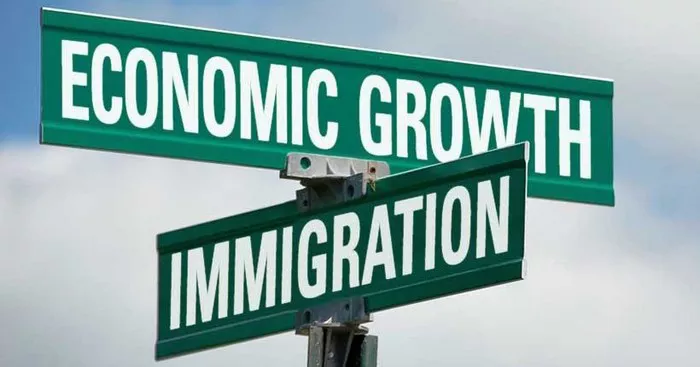Preliminary data on the US gross domestic product (GDP) for the first quarter of 2024 is anticipated to underscore a sustained economic upturn propelled by a surge in immigration.
The forthcoming figures, scheduled for release by the Bureau of Economic Analysis on Thursday, are expected to reveal a 2.5% annualized expansion in GDP during the initial three months of the year, according to a Bloomberg survey’s median estimate. Additionally, consumer spending is projected to advance by 3%.
While these estimates represent a slight deceleration from the growth rates observed in the previous quarter, they would translate to an overall acceleration in GDP growth over a four-quarter period, marking the swiftest pace in two years. Economists have adjusted their forecasts upwards following a recent report from the Congressional Budget Office, which indicated a higher-than-anticipated level of immigration.
Key highlights to observe within the report’s components include:
Consumer Spending
Personal consumption expenditures, constituting approximately two-thirds of GDP, are anticipated to have continued driving growth in the first quarter. Monthly data from January and February showcased a robust increase in services spending, with a slight downturn in goods spending.
Bloomberg economists, led by Anna Wong, noted, “Consumers augmented spending on retail in March, while spending on food services – a primary indicator for services in the retail-sales report – remained robust.” They attributed this trend to strong payroll numbers, bolstered by an augmented labor supply, which supported overall income growth and subsequently, consumption.
Investment
Business investment is expected to have experienced a more modest rise in the first quarter. March’s monthly figures on durable goods orders revealed a 1.5% annualized decline in nondefense capital goods shipments, hinting at a probable reduction in equipment outlays within the GDP data.
Citi economists Alice Zheng and Andrew Hollenhorst observed, “Weather conditions and aircraft orders have introduced some volatility in recent data, but overall, we anticipate business investment to remain subdued, impacted by higher interest rates.”
Conversely, residential investment likely made the most significant contribution to GDP growth since 2020, according to Goldman Sachs economist Spencer Hill. Lower mortgage rates during the first quarter compared to the final quarter of 2023 helped bolster sales of new and existing homes, although rates have since climbed in recent weeks.
Government Spending
Economists also view government spending as a notable driver of GDP growth in the first quarter, partially attributed to ongoing recuperative efforts at the state and local levels, where spending was curtailed during the pandemic.
This rebound is evident in monthly employment data, with local government headcount increasing by 3.4% annualized in the first quarter – the most substantial uptick since 2021. Similarly, state government payrolls saw a comparable rise.
Michael Reid, Chief US Economist at RBC Capital Markets, remarked, “We anticipate government spending will be the second largest contributor to growth, as state and local spending continues to close its post-Covid spending gap.”


